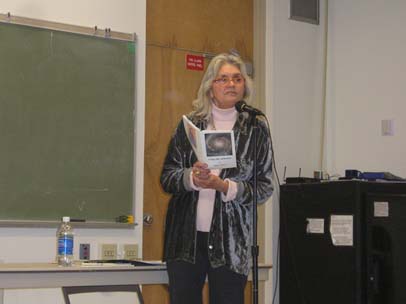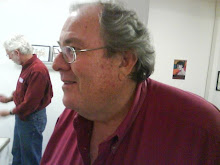
Julia Connor is Sacramento’s current poet laureate, and she read a wide swath of her poetry at American River College for a group of mostly students. A trail of candy leading to the venue produced few attendees. Most attended for “extra credit” points. Overheard before the reading even started: “I’m not even sure what a poet laureate is supposed to look like.”
Julia Connor ranged from her early work to pieces that were still in progress, that were, in the poet’s words, “close, but no cigar.” Connor’s work often is fortified by her interest in refracted interiors or as she put it, her work merges place with memory. The places she writes in echo inside her to produce a sound which seems to emanate from more than one source.
Early on her work grew out of her domestic situation. “Song for the Wood-Framed House” was her first published piece in a magazine called Quercus (the name of an oak tree), and old publication of none other than the Sacramento Poetry Center. This is a long piece that progresses from scene to scene. In it the speaker initially speaks of four wooden shelves that arrive from Florida which prod the speaker to enter into a dialog with the house. A storm arrives. Her daughter and son are introduced, the son intoning, “there is something that is not clear,” a sentiment that the listener/reader sympatthizes with as Connor’s domestic scenes deepen in complexity. The son plays French horn. The daughter is speaking. The daughter’s shouting is in dialog with the son’s french horn. The speaker continues to remain thoroughly suspended in the moment. The moment is in flux. The poem’s main concern is to remain in the present, to examine it and be held still by its emergent forms. Finally, in the last line, the speaker asserts, “we are strung, small beads of wonder in the fire.”
Connor then went on to discuss what it is like to get lost in a poem, how the poem takes over the poet’s mind and directs it to different places, often without signal or warning. For this process of imagining, Connor used the wonderfully apt metaphor of this process being like “riding a bike without wheels.”
“One February Evening on the 6 ‘o Clock News” begins with the speaker’s comparison of voles versus rats. The speaker then reveals that she is pregnant and that the rat in the family (formerly thought of as male) is also pregnant. Competition between the two ensues. However, when the rat gives birth, it starts to eat its young (presumably due to the mother’s immaturity and trauma in its own infancy). As the baby rats die, the speaker gets sucked into this drama so that all the other animals die as well. The fish in the aquarium die. The last image in the poem is the arrival of the child on the same day as the death of the last fish in the tank, suggesting some preternatural soul exchange.
To introduce her next poem, Connor described the act of “scrying” a photograph which Connor describes as “seeing into things.” By this she means looking very intently at objects until that object’s internal qualities come alive. This is akin to what Bly preaches in his comments about “the object poem.” One meditates on an object like it is a crystal with the hope and confidence that the unforeseen qualities of that object come to the surface. “Photograph in the Landscape of my Mother” features the speaker transmogrified into gull. The speaker focuses on its/her mother until the gull dredges up the mother in “wave after wave.”
After reading the previous works from the distant past, Connor then turned to new works. She described “Joe’s Poem” as a new poem that was nearly finished but still had some tinkering to undergo. She discussed how the poem had grown out of an 8-lime fragment she had written and read for a particular occasion. Afterwards, though, she was dissatisfied with this cursory treatment, and she set out to develop the poem in a more-fully-fleshed-out form. Joe is openly revealed as the speaker’s father, and the begininng of the poem describes in detail a father-daughter fishing incident and the bond that grew there in that setting. The speaker addresses the importance of a father for a daughter through example. finally, the last scene reveals the father at the daughter’s communion where blood (wine) appears on the father’s shirt. It is “blood that ruins and writes.”
“Tommy Dollard” is about a girlhood crush and the instant at which the speaker realizes that moment in the relationship which inscribes her otherness.
“The Visiting Room” begins to encroach on Connor’s later adult life, away from the family and the home. It is in this later incarnation where Connor’s speaker has an encounter with a prisoner. the poem is informed by her days as visiting poet/teacher in the prisons where creative writing was used as a tool to resocialize and rehumanize the prisoners. [Connor points that currently such a program has been discontinued. does this mean that the life of the prisoner is unable to be tethered again to the frame of the human?] The speaker in the poem relates the life story of an inmate who recollects how he unknowingly shoots his kid sister. The inmate reflects that this one formative experience shapes his past as burglar and man who never felt quite right in the shoes of the human. The inmate describes how the presence of his sister is washed away from him so that he can forget about her and not be reminded of her presence, but the inmate can’t. The last image in the poem is of the prisoner being led away while a siren sounds on the TV.
The last piece that Connor read which dealt with her life experience was a section from “Canto for the Birds,” a book-length poem that grew out of a trip that Connor and her husband took while they went visiting Arizona. They stopped at every bird sanctuary in The Valley as they headed south, each one and its associated species of birds serving as anchors in the poem. Again, in this poem prisoners surface. But here the drama of their life stories is not featured. Instead, Connor chooses to use them as foil for her reflection, how she has earned grace from them and her experience with them. The speaker muses that the prisoners have eased her into the grace of old age where the speaker can risk being ridiculous.
The last two pieces were read in honor of Women’s History Month. The first piece challenged the audience with its take on the ancient practice of Chinese foot binding. The other sought a spirit of camaraderie with downtrodden females around the world.
Connor’s poems carve out the familiar, where Connor seeks to affirm her place in the world, but she also pushes her craft out into the world as it remains moored by the labyrinths of memory.





















No comments:
Post a Comment